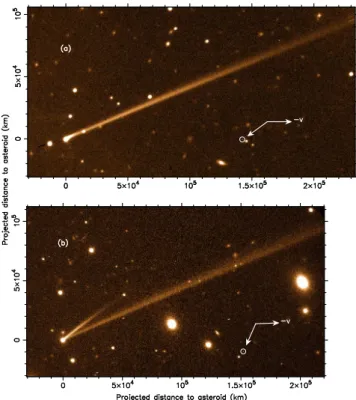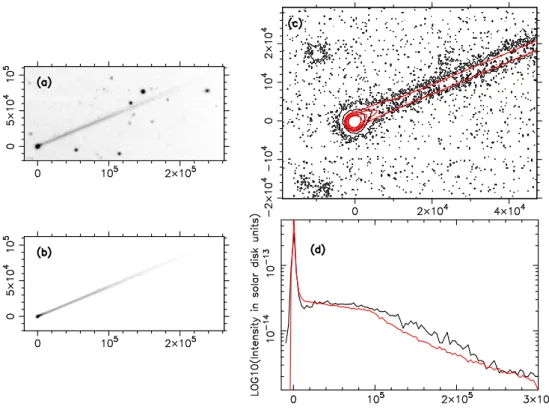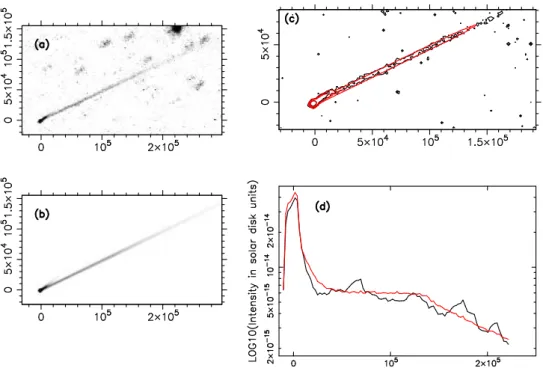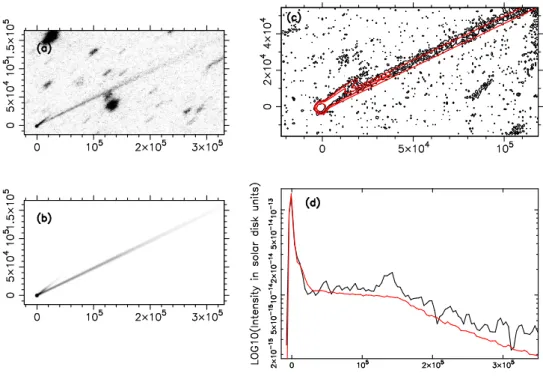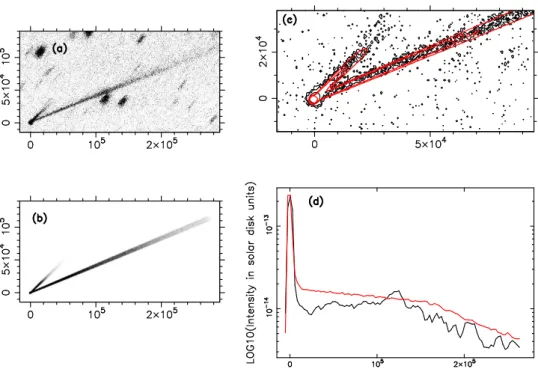April 15, 2019
Letter to the Editor
Dust Properties of Double-Tailed Active Asteroid (6478) Gault
F. Moreno
1, E. Jehin
2, J. Licandro
3, 4, M. Ferrais
2, Y. Moulane
2, 6, 8, F.J. Pozuelos
2, 5, J. Manfroid
2, M. Devogèle
7, Z.
Benkhaldoun
6, N. Moskovitz
7, M. Popescu
3, 4, M. Serra-Ricart
3, 4, A. Cabrera-Lavers
9, 3, 4, and M. Monelli
3, 41 Instituto de Astrofísica de Andalucía, CSIC, Glorieta de la Astronomía S/N, 18008 Granada, Spain
e-mail: fernando@iaa.es
2 Space sciences, Technologies & Astrophysics Research (STAR) Institute, Université de Liège, 4000 Liège, Belgium 3 Instituto de Astrofísica de Canarias, Vía Láctea s/n, 38205, La Laguna, Spain
4 Departamento de Astrofísica, Universidad de La Laguna, 38206, La Laguna, Tenerife, Spain 5 EXOTIC Lab, UR Astrobiology, AGO Department, University of Liège, 4000 Liège, Belgium
6 Oukaimeden Observatory, High Energy Physics and Astrophysics Laboratory, Cadi Ayyad University, Marrakech, Morocco 7 Lowell Observatory, 1400 West Mars Hill Road, Flagstaff, AZ 86001 (U.S.A.)
8 ESO (European Southern Observatory) - Alonso de Cordova 3107, Vitacura, Santiago Chile 9 GRANTECAN, Cuesta de San José s/n, E-38712 Breña Baja, La Palma, Spain
April 15, 2019
ABSTRACT
Context.Asteroid (6478) Gault was discovered to exhibit a comet-like tail in observations from December 2018, becoming a new
member of the so-called active asteroid population in the main asteroid belt.
Aims.The aims are to investigate the grain properties of the dust ejected from asteroid (6478) Gault and to give insight into the activity
mechanism(s).
Methods.We use a Monte Carlo dust tail brightness code to retrieve the dates of dust ejection, the physical properties of the grains,
and the total dust mass losses during each event. The code takes into account the brightness contribution of the asteroid itself. The model is applied to a large data set of images spanning the period from January 11, 2019 to March 13, 2019. In addition, both short-and long-term photometric measurements of the asteroid have been carried out.
Results.It is shown that, to date, asteroid (6478) Gault has experienced two episodes of impulsive dust ejection, that took place
around 2018 November 5 and 2019 January 2, releasing at least 1.4×107kg and 1.6 ×106kg of dust, respectively, at escape speeds.
The size distribution, consisting of particles in the 1 µm to 1 cm radius range, follows a broken power-law with bending points near 15 µm and 870 µm. On the other hand, the photometric series indicate a nearly constant magnitude over several 5–7.3 h periods, a possible effect of the masking of a rotational lightcurve by the dust.
Conclusions. The dust particles forming Gault’s tails were released from the asteroid at escape speeds, but the specific ejection
mechanism is unclear until photometry of the dust-free asteroid are conducted, in order to assess whether this was related to rotational disruption or to other possible causes.
Key words. Asteroids: (6478) Gault – Techniques:image processing, photometric – Methods: numerical –
1. Introduction
Main belt asteroid (6478) Gault (hereinafter Gault for short), a member of the 25 Phocaea asteroid family (Small Bodies Data Ferret, NASA Planetary Data System, see https://sbnapps.psi.edu/olaf/) was reported to have a comet-like tail at PA=290◦on December 8, 2018, from ATLAS images, and early Finson-Probstein (Finson & Probstein, 1968) analysis of those images revealed ejection of material in early November 2018 (Smith et al. 2019). Previous images from ATLAS and PanSTARRS back to 2010 do not show any sign of activity. Follow-up imaging of the object revealed the presence of an-other growing tail-like structure at about PA=305◦ (Jehin et al. 2019), probably associated to a second ejection event.
The orbital elements of Gault are a=2.305 au, e=0.194, and i=22.81◦, so it is an inner main belt object with a Tisserand pa-rameter with respect to Jupiter of T=3.46. This classifies Gault as a new member of the active asteroid population (e.g., Jewitt et al. 2015). As with many other active asteroids that show long-term dynamical stability (e.g. Haghighipour 2009, Jewitt et al.
2009), its orbit is stable on timescales of 100 Myr or longer, as we have verified by backward dynamical evolution using the Mercury integrator (Chambers 1999) starting from the current orbital elements of Gault. This implies that Gault is a native member of the main belt. Among the possible causes for the ac-tivity in these objects, impact, rotational breakup, and ice sub-limation (or even a combination of these) are usually invoked (see Jewitt et al. 2015 for a complete description of the possi-ble mechanisms involved). In principle, ice-sublimation-related activity on Gault seems unlikely owing to its character of inner belt asteroid. Likewise, the occurrence of two succesive impacts seems rather improbable.
The appearance of Gault is becoming similar to asteroid 311P (Jewitt et al. 2013, Moreno et al. 2014, Hainaut et al. 2014), currently described as a close binary in which one of the compo-nents rotates near the centripetal limit (Jewitt et al. 2018).
In this paper, we describe observations and models of Gault to impose constraints on the physical properties of the ejected dust, and to shed light on the activity timeline and causes for the ejection events.
Fig. 1. Sample images of asteroid (6478) Gault. Panel (a) shows the image obtained on January 14, 2019, with OSIRIS at the 10.4m Gran Telescopio Canarias, through a Sloan r filter. Panel (b) shows an image obtained on February 15, 2019, with SOAR 4.1m telescope through a V+ Rcbroadband filter. North is up, East to the left. The directions to the Sun and the negative of the heliocentric velocity vector (v) are shown.
2. Observations and data reduction
Images of Gault have been obtained at various telescopes around the world in the time frame from January 11 to February 15, 2019. Table 1 shows the log of the observations. Except for the observations from SOAR 4.1m telescope, in which a broadband V+ Rcfilter was used, either Sloan r or Rc(Cousins) filters were used. The images from GTC 10.4m telescope were calibrated using standard stars, while in all the other cases, field stars and the USNO-B1.0 catalogue was used in the reduction procedure. Median stacking was performed for the TRAPPIST (Jehin et al. 2011) images to improve the signal-to-noise ratio. The seeing disk varied between 0.8 and 1.5 arcsec FWHM.
The early images show a single narrow tail near PA=290◦, and a dense nuclear condensation (Figure 1a). Since early Febru-ary, a second tail started to show up near PA=305◦(Figure 1b).
In addition to the images, long photometric series were ob-tained with both TRAPPIST-North (TN) and -South (TS) on 2019 January 13, 14 and 15, in order to determine the rotation period of the asteroid. In total we acquired 5 lightcurves of about 5 hours each, taken with the Rcfilter and an exposure time of 120 s (Table 2). On January 14 and 15, we observed first with TN and then with TS, all with the Rcfilter, which allowed continuous ob-servation during 7.3 hours, with some overlap between the two telescopes. The calibration of the images was made with IRAF scripts using corresponding flat fields, bias and dark frames. The photometry was derived using the PhotometryPipeline (Mom-mert 2017). About 700 to 900 stars in the PanSTARRS catalogue were used for the photometric calibration to obtain the apparent Rcmagnitudes.
3. The Dust Tail Brightness Code
In the simulations of the tails brightnesses, we used our Monte Carlo dust tail code that has been already described in several works in the past to characterise the dust environments of comets and main-belt comets (see e.g. Moreno et al. 2016, Moreno et al. 2017), so that only a brief description is given. The dynamics of the particles (assumed spherical) are described by the β pa-rameter, defined as β= CprQpr
ρd , where d is the particle diameter, Cpr=1.19×10−4g cm−2is the radiation pressure coefficient, and Qpr is the scattering efficiency for radiation pressure, which is Qpr ≈1 for absorbing particles large compared to the observa-tion wavelength (Burns 1979).
As Gault is an inner belt asteroid of likely S-type, the particle density is assumed at ρ=3400 kg m−3, which is appropriate for S-type asteroid Itokawa regolith (Tsuchiyama et al. 2011). The code computes the position in the sky plane of a large number of particles emitted isotropically from the asteroid, whose trajecto-ries depend on β and their terminal velocities (e.g., Fulle 1989). We assume a broad differential size distribution of particles be-tween 1 µm and 1 cm in radius, following a power-law function. Prior to this activity period, Gault absolute magnitude has been reported as H=14.4 (JPL Small-Body Database). We as-sume a geometric albedo of pv=0.15, appropriate for a S-type asteroid (e.g. Luu & Jewitt 1989). Then, its diameter can be cal-culated as D=4.5 km, using the equation by Harris & Lagerros (2002). Owing to its significant size, we added in the simula-tions the asteroid brightness contribution to the tail brightness, assuming a constant cross section with time. To produce real-istic model images to be compared with the observations, we performed a convolution of the synthetic images obtained with
Table 1. Journal of the observations: imaging.
Telescope/Instrument Date (UT) r ∆ α Scale
(au) (au) (deg) arcsec/pixel TCS/MuSCAT2 2019-01-11T02:43 2.464 1.822 20.3 0.434 GTC/OSIRIS 2019-01-13T06:56 2.460 1.794 19.8 0.254 GTC/OSIRIS 2019-01-14T06:12 2.458 1.781 19.7 0.254 TRAPPIST-S 2019-01-21T00:11 2.444 1.699 18.1 1.250 TRAPPIST-S 2019-01-29T05:36 2.428 1.608 15.9 1.250 TRAPPIST-S 2019-02-05T02:45 2.414 1.541 13.7 1.250 TRAPPIST-S 2019-02-07T07:22 2.410 1.523 12.9 0.625 SOAR 2019-02-15T06:37 2.394 1.463 10.1 0.290 TRAPPIST-S 2019-03-05T05:34 2.356 1.388 6.9 0.625 TRAPPIST-S 2019-03-13T04:48 2.338 1.384 8.8 0.625
Notes. Telescope acronyms: TCS: 1.52m Carlos Sánchez Telescope at Tenerife. GTC: 10.4m Gran Telescopio Canarias. TRAPPIST: 0.6m Tran-siting Planets and Planetesimals Small Telescope. SOAR: 4.1m Southern Astrophysical Research Telescope.∆ and r are the asteroid geocentric and heliocentric distances, respectively, and α is the phase angle.
Table 2. Summary of Gault short-term photometric series (RCfilter).
Date Np r ∆ α Site
(UT) (au) (au) (deg)
2019-01-13.3 119 2.46 1.79 19.9 TRAPPIST-S 2019-01-14.2 124 2.46 1.78 19.7 TRAPPIST-N 2019-01-14.3 134 2.46 1.78 19.7 TRAPPIST-S 2019-01-15.2 124 2.45 1.77 19.5 TRAPPIST-N 2019-01-15.3 131 2.45 1.77 19.4 TRAPPIST-S
a two-dimensional Gaussian function. The full-width at half-maximum of the Gaussian was set to the average seeing value at the corresponding observation date. The asteroid and the dust particles brightness were corrected for the effect of the phase angle. For the asteroid we applied a linear phase coefficient of b=0.033 mag deg−1, which is computed from the relation by Belskaya & Shevchenko (2000). For the dust particles ejected, we assumed the same values of pvand b as for the asteroid.
The remaining model parameters are the event times and du-ration, the dust masses ejected, and the terminal particle speeds. The speed is assumed to follow a law of the kind v = v0βγ. For a sublimating body in which particles are accelerated by gas drag, γ ∼0.5. For a simple model of rotational disruption, a size-independent speed would be expected, so that γ ∼0. The event times are preliminarily guessed by a syndyne-synchrone anal-ysis (Finson & Probstein 1968), which applies to zero ejection velocity conditions, and then refined by the Monte Carlo dust tail model. The dust loss rates are assumed constant during the occurrence of the ejection events.
The fitting procedure is accomplished by performing a min-imisation of the quantity σ =
l=N P l=1
σl, where the summation is extended to all the images included in the analysis, and σl =
r P i, j
(log10[Bobs(i, j)]−log10[Bmod(i, j)])2
Nl is the standard deviation
of the model brightness (Bmod) with respect to the observed brightness(Bobs) for image l, where (i, j) represent the image pixel location, and Nlthe total number of pixels of image l. This minimization is performed using a multidimensional downhill simplex method (Nelder & Mead 1965).
4. The Lightcurve
The aim of obtaining the lightcurves was primarily to search for the rotation period of Gault. The apparent Rcmagnitudes were converted to absolute magnitudes H by assuming V − Rc=0.49 (Shevchenko & Lupishko 1998), and a slope parameter G=0.227 (Warner et al. 2009), both values appropriate for S-type as-teroids. The resulting lightcurves are shown in Figure 2. Each lightcurve is essentially flat, except for a weak slope in the first half of the lightcurve of January 13. All these data did not al-low us to determine a rotation period or to observe any trend of the magnitude on several consecutive days. If the rotation period of Gault was an integer divider of 24 h, we would have observed the same part of the rotation each time. However, as we observed 3 nights continuously for 5 h, 7.3 h and 7.3 h, respectively, it is very unlikely that we were observing each time the same flat part of its lightcurve. The possibilities to explain a flat lightcurve for an asteroid include a nearly spherical shape, pole-on observation, and the presence of dust around the asteroid hiding its surface. Fast rotators typically present a roughly spheroidal shape, re-sembling a spinning top. The amplitude of the lightcurves of this kind of asteroids is small (i.e.,.0.2 mag). If the object is embed-ded in a coma this small variation can easily be masked (Lican-dro et al. 2000). For Gault, given the magnitude of the inactive asteroid (H=14.4), we find that approximately half of the total brightness is produced by the dust envelope on the lightcurve dates. A recent study performed by Kleyna et al. (2019) points to a ∼2h rotation period for Gault, which would indicate a super-fast rotator and probable rotational disruption as the cause of the dust ejection. Further photometric observations when the aster-oid will have no detectable coma can give additional results on the rotation properties.
5. Results and Discussion
Since the number of free parameters in the model is large, in or-der to make the problem tractable we had to perform preliminary searches of some of the input parameters. Thus, the exponent γ in the particle ejection speed equation was set to γ=0.5. Al-though this value is appropriate to gas drag acceleration from an ice-sublimating body, we had to assume it in order to explain the observed widening of the main tail as a function of distance to the asteroid, mainly for the latest images acquired (see Figure 1b and Figures A.8 to A.10). At present, we do not find any expla-nation for this fact, as ice sublimation seems rather improbable.
Fig. 2. Absolute H magnitude lightcurves of (6478) Gault obtained with TRAPPIST-North (TN) and -South (TS) on 2019 January 13, 14 and 15. The TS 2019 January 13 data correspond to the true magnitude values on the y-axis, while the other datasets are shifted by multiples of 0.3 mag downwards, as indicated. Errors correspond to 2σ.
The overall width of the tails depend on v0. We found a value v0= 3 m s−1as appropriate, which implies terminal speeds values of ∼0.4 m s−1 for 10 µm particles, and lower for larger particles. These terminal speeds are comparable to the escape velocity of the asteroid at distances where the asteroid gravity becomes neg-ligible compared to solar gravity. Thus, if we assume for the bulk density of the asteroid a value typical for S-type (ρbulk=2710 kg m−3, Krasinsky et al. 2002), the escape velocity at 100 km from the asteroid surface would be ∼0.4 m s−1, where the ratio of solar gravity to asteroid gravity is larger than 103. This indicates that the particles populating Gault tails were likely released at near escape speeds from the asteroid surface. This would be compati-ble with a rotational breakup. However, the speed dependence on particle size seems incompatible with this mechanism. A simple model of rotational disruption would yield a size-independent ejection speed.
On the other hand, the event times are preliminarily guessed by a syndyne-synchrone analysis (Finson & Probstein 1968), which applies to zero ejection velocity conditions, and then re-fined by the Monte Carlo dust tail model. The duration of such events is only weakly constrained by the model, provided they are shorter than ∼5 days. We then fixed the duration to 1 day for simplicity, but keeping in mind that this can be in fact much shorter.
After these preliminary searches of the mentioned parame-ters, we then solved for the total mass of dust ejected, and the power-law index of the differential size distribution. It soon be-came apparent that a single power-law function was inadequate to describe the variation of the brightness of the main tail with distance to the asteroid. It comes from the fact that the brightness along the tail first slightly increases or keeps constant tailward, and finally decreases (see Figure 1, and Figures A.1-A.10). In order to fit properly the observed brightness profile we adopted a broken power-law with two bending points. This left us with a total of seven fitting parameters: the two bending points, the three power-law indexes, and the dust mass released during each event. The resulting best-fitted differential size distribution was
characterised by power-law indexes of –2.28 (between 1 µm and 15 µm), –3.95 (between 15 µm and 870 µm), and –4.22 (be-tween 870 µm and 1 cm). This probably reflects the asteroid regolith size distribution. Broken power-law functions are com-mon when describing the size distributions of asteroid dust bands (Nesvorný et al. 2006), the boulder distribution in asteroid re-goliths (Tancredi et al. 2015), or in cometary dust (Fulle et al. 2016, Moreno et al. 2016), always with a tendency to increase slope with size.
The total dust mass released were of 1.4×107, and 1.6×106 kg, for the 2018 November 5, and 2019 January 2 events, respec-tively. We need to emphasise that these masses are lower limits to the actual total dust mass ejected. Thus, should a few large and massive boulders have been ejected, they would not contribute significantly to the brightness, but would do to the mass. We un-derline that the same differential size distribution is assumed for the two ejection events.
It is very interesting to note the remarkably similar size dis-tribution, ejected masses, and velocities recently reported by Ye et al. (2019).
The fits to the data are shown in Figures A.1-A.10 in Ap-pendix 1. These fits are provided as a synthetic image which best fits the observed image at a given date, an isophote map show-ing the measured and the modelled isophotes near the asteroid location, and the brightness along the tail, for both the observa-tion and the model. The “bumps” along some of these measured profiles (most evident in Figures A.4, A.5, A.7, A.9, and A.10) are due to contamination by field stars. The asteroid contribution to the brightness profile near the optocenter is more and more important as time progresses, as the dust is being blown away by radiation pressure.
The total mass ejected, 1.56×107kg, is negligible compared to the asteroid mass (1.3×1014 kg), and would correspond to a spherical volume of just ∼10 m radius.
6. Conclusions
We have carried out observations and models to characterise the dust properties and event timelines of the double-tailed active asteroid Gault. The following conclusions can be drawn:
1. Asteroid Gault has experienced two short-lived activity peri-ods of a maximum duration of 5 days, but might be much shorter, separated by a period of inactivity of nearly two months. A similar activity pattern has been previously ob-served for inner belt asteroid 311P.
2. The total dust masses ejected for particles in the 1 µm to 1 cm radius were 1.4×107, and 1.6×106 kg, for the November 5, 2018, and January 2, 2019 events, respectively. These masses represent a negligible fraction of the asteroid mass, estimated at 1.3×1014kg.
3. To fit the brightness distribution along the main tail, the dif-ferential size distribution function can be described as a bro-ken power-law function, with power indexes of –2.28, –3.95, and -4.22, and bending points near 15 µm and 870 µm. 4. The ejection speeds are found to be close to the escape speed
of Gault, a fact compatible with rotational disruption phe-nomena. However, the model results point to a β0.5 depen-dence of the speeds, typical of sublimation-driven processes. This mechanism is, however, very unlikely owing to the in-ner belt character of the object. Only a detailed lightcurve of the naked, dust-free, asteroid in combination with dynamical modelling might shed additional light on the ejection mech-anism.
Acknowledgements. We would like to thank the reviewer for his/her construc-tive comments which helped to substantially improve the quality of the paper. F. Moreno acknowledges financial support from the State Agency for Research of the Spanish MCIU through the "Center of Excellence Severo Ochoa" award for the Instituto de Astrofísica de Andalucía (SEV-2017-0709). This article is par-tially based on observations made with the Gran Telescopio Canarias, installed in the Spanish Observatorio del Roque de los Muchachos of the Instituto de As-trofísica de Canarias (IAC), in the island of La Palma and on observations made in the Observatorios de Canarias del IAC with the MUSCAT2 instrument on the Carlos Sanchez telescope operated on the island of Tenerife by the IAC in the Observatorio del Teide. TRAPPIST-North is a project funded by the Univer-sity of Liège, in collaboration with Cadi Ayyad UniverUniver-sity of Marrakech (Mo-rocco). TRAPPIST-South is a project funded by the Belgian Fonds (National) de la Recherche Scientifique (F.R.S.-FNRS) under grant FRFC 2.5.594.09.F. E.J and M.G are F.R.S.-FNRS Senior Research Associates. This work is also based on observations obtained at the Southern Astrophysical Research (SOAR) tele-scope, which is a joint project of the Ministério da Ciência, Tecnologia, e In-ovação (MCTI) da República Federativa do Brasil, the U.S. National Optical Astronomy Observatory (NOAO), the University of North Carolina at Chapel Hill (UNC), and Michigan State University (MSU). This work was supported by contracts AYA2015-67152-R and AYA 2015-71975-REDT from the Span-ish Ministerio de Economía y Competitividad (MINECO). J. Licandro gratefully acknowledges support from contract AYA2015-67772-R (MINECO, Spain).
References
Belskaya, I.N., & Shevchenko, V.G. 2000, Icarus, 147, 94 Burns, J.A., Lamy, P.L., Soter, S. 1979, Icarus, 40, 1 Chambers, J.E., 1999, MNRAS, 304, 793
Finson, M.L., & Probstein, R.F. 1968, ApJ, 154, 353 Fulle, M. 1989, A&A, 217, 283
Fulle, M., Marzari, F., Della Corte, V., et al. 2016, ApJ, 821, 19
Hainaut, O.R., Boehnhardt, H., Snodgrass, C., et al. 2014, A&A, 563, A75 Harris, A.W., & Lagerros, J.S.V. in Asteroids III, Univ. of Arizona Press, Tucson Haghighipour, N., 2009, Meteor. and Planet. Sci., 44,1863
Jehin, E., Gillon, M., Queloz, D., et al. 2011, The Messenger, 145
Jehin, E., Ferrais, M., Moulane, Y., et al. 2019, Central Bureau Electronic Tele-grams, 4606
Jewitt, D., Yang, B., Haghighipour, N. 2009, AJ, 137, 4313 Jewitt, D., Agarwal, J., Weaver, H., et al. 2013, ApJ, 778, L21
Jewitt, D., Hsieh, H., and Agarwal, J. 2015, in Asteroids IV, Univ. of Arizona Press, Tucson
Jewitt, D., Weaver, H., Mutchler, M., 2018, AJ, 155, 231
Kleyna, J.T., Hainaut, O.R., Meech, K.J., et al. 2019, ApJ Lett., in press Krasinsky, G.A., Pitjeva, E.V., Vasilyev, M.V. et al. 2002, Icarus, 158, 98 Licandro, J., Serra-Ricart, M., Oscoz, A. et al. 2000, Astron. J., 119, 3133 Luu, J., & Jewitt, D., 1989, Astron. J., 98, 1905
Mommert, M. 2017, Astronomy and Computing, 18, 47
Moreno, F., Licandro, J., Álvarez-Iglesias, C., et al. 2014, ApJ, 781, 118 Moreno, F., Snodgrass, C., Hainaut, O., et al., 2016, A&A, 587, 155 Moreno, F., Pozuelos, F.J., Novakovi´c, B., et al., 2017, ApJ, 837, L3 Nelder, J.A., & Mead, R. 1965, Computer Journal, 7, 308
Nesvorný, D., Vokrouhlický, D., Bottke, W.F. et al. 2006, Icarus, 181, 107 Smith, K.W., Denneau, L., Vincent, J.B., et al. 2019, CBET 4594. Shevchenko, V.G., & Lupishko, D.F. 1998, Solar Syst. Res. 32, 220 Tancredi, G., Roland, S., and Bruzzone, S. 2015, Icarus, 247, 279
Tsuchiyama, A., Uesugi, M., Matsushima, T., et al. 2011, Science, 333, 1125 Warner, B.D., Harris, A.W., Pravec, P. 2009, Icarus, 202, 134
Appendix A: Monte Carlo dust tail model fits to the images
In this Appendix we show the model fits for all the images shown in Table 1.
Fig. A.1. Results of the model fit for the image obtained with TCS on 2019 January 11. Panel (a) is the observed image. Panel (b) is the model image, using the same brightness scale as in (a). Panel (c) shows the isophote field near the asteroid location (observation in black contours, and model in red contours). In Panel (d), a comparison between the observed intensity along the main tail (black line), and the model (red line), is given. Axes are labelled in km projected on the sky at the asteroid distance. In panels (a)-(c), North is up, East to the left.
Fig. A.3. As Figure A.1, but for the GTC image on 2019 January 14.
Fig. A.5. As Figure A.1, but for the TRAPPIST image on 2019 January 29.
Fig. A.7. As Figure A.1, but for the TRAPPIST image on 2019 February 7.
Fig. A.9. As Figure A.1, but for the TRAPPIST image on 2019 March 5.
